Conditioning Drill 1 (CD 1)
APPENDIX A
CONDITIONING DRILL ONE
Conditioning Drill 1
Exercise 1: The Bend and Reach
Purpose: This exercise develops the ability to squat and reach through the legs. It also serves to prepare the spine and extremities for more vigorous movements, moving the hips and spine through full flexion.
Starting Position: Straddle stance with arms overhead.
Cadence: SLOW.
Count:
- Squat with the heels flat as the spine rounds forward to allow the straight arms to reach as far as possible between the legs.
- Return to the starting position.
- Repeat count one.
- Return to the starting position.
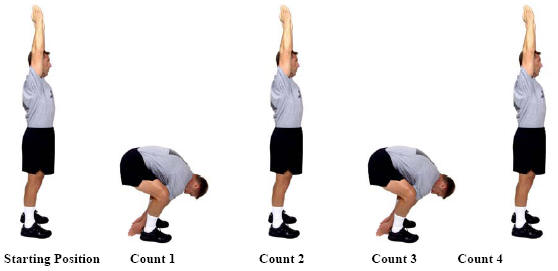
Check Points:
- From the starting position, ensure that soldiers have their hips set, their abdominals tight, and their arms fully extended overhead.
- The neck flexes to allow the gaze to the rear. This brings the head in line with the bend of the trunk.
- The heels and feet remain flat on the ground.
- On counts two and four, do not go past the starting position.
Precautions: This exercise is always performed at a slow cadence. To protect the back, move into the count one position in a slow, controlled manner. Do not bounce into or out of this position in a ballistic manner, as this may place an excessive load on the back.
Conditioning Drill 1
Exercise 2: The Rear Lunge
Purpose: This exercise promotes balance, opens up the hip and trunk on the side of the lunge and develops leg strength.
Starting Position: Straddle stance with hands on hips.
Cadence: SLOW.
Count:
- Take an exaggerated step backward with the left leg, touching down with the ball of the foot.
- Return to the starting position.
- Repeat count one with the right leg.
- Return to the starting position.
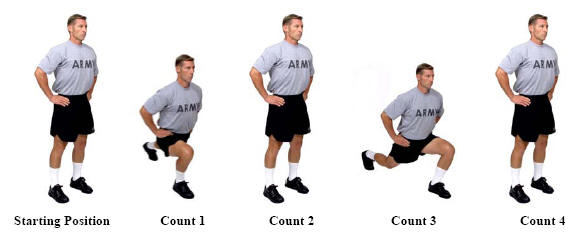
Check Points:
- Maintain straightness of the back by keeping the abdominal muscles tight throughout the motion.
- After the foot touches down, allow the body to continue to lower. This promotes flexibility of the hip and trunk.
- On counts one and three, step straight to the rear, keeping the feet directed forward. When viewed from the front, the feet maintain their distance apart both at the starting position and at the end of counts one and three.
- Keep the rear leg as straight as possible but not locked.
Precautions: This exercise is always performed at a slow cadence. On counts one and three, move into position in a slow, controlled manner. If the cadence is too fast, it will be difficult to go through a full range of motion.
Conditioning Drill 1
Exercise 3: The High Jumper
Purpose: This exercise reinforces correct jumping and landing, stimulates balance and coordination, and develops explosive strength.
Starting Position: Forward Leaning Stance.
Cadence: MODERATE.
Count:
- Swing arms forward and jump a few inches.
- Swing arms backward and jump a few inches.
- Swing arms forward and vigorously overhead while jumping forcefully.
- Repeat count two. On the last repetition, return to the starting position.
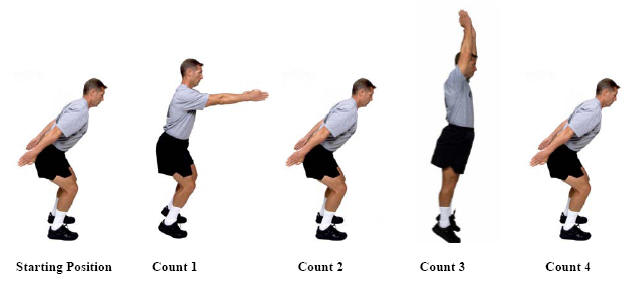
Check Points:
- At the starting position, the shoulders, the knees, and the balls of the feet should form a straight vertical line.
- On count one, the arms are parallel to the ground.
- On count three, the arms should be extended fully overhead. The trunk and legs should also be in line.
- On each landing, the feet should be directed forward and maintained at shoulder distance apart. The landing should be “soft” and proceed from balls of the feet to the heels. The vertical line from the shoulders through the knees to the balls of the feet should be demonstrated on each landing.
Precautions: N/A.
Conditioning Drill 1
Exercise 4: The Rower
Purpose: This exercise improves the ability to move in and out of the supine position to a seated posture. It coordinates the action of the trunk and extremities while challenging the abdominal muscles.
Starting Position: Supine position, arms overhead, feet together and pointing upward. The chin is tucked and the head is 1-2 inches above the ground. Arms are shoulder-width, palms facing inward with fingers and thumbs extended and joined.
Cadence: SLOW.
Count:
- Sit up while swinging arms forward and bending at the hip and knees. At the end of the motion, the arms will be parallel to ground, palms facing inward.
- Return to the starting position.
- Repeat count one.
- Return to the starting position.
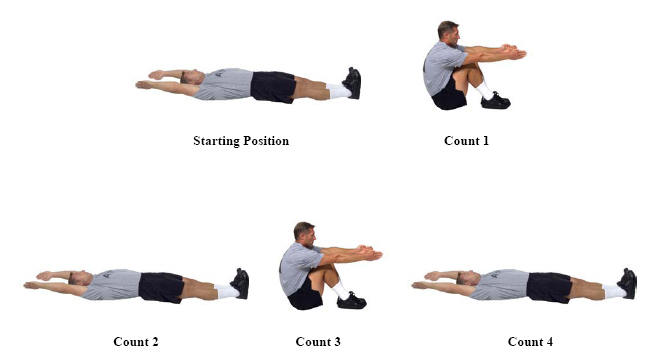
Check Points:
- At the starting position, the low back must not be arched excessively off the ground. To prevent this, tighten the abdominal muscles to tilt the pelvis and low back toward the ground.
- At the end of counts one and three, the feet are flat and pulled near the buttocks. The legs stay together throughout the exercise and the arms are parallel to the ground.
Precautions: This exercise is always performed at a slow cadence. Do not arch the back to assume counts one and three.
Conditioning Drill 1
Exercise 5: The Squat Bender
Purpose: This exercise develops strength, endurance and flexibility of the lower back and lower extremities.
Starting Position: Straddle stance with hands on hips.
Cadence: SLOW.
Count:
- Squat while leaning slightly forward at the waist with the head up and extend the arms to the front, with arms parallel to the ground and palms facing inward.
- Return to the starting position.
- Bend forward and reach toward the ground with both arms extended and palms inward.
- Return to the starting position.
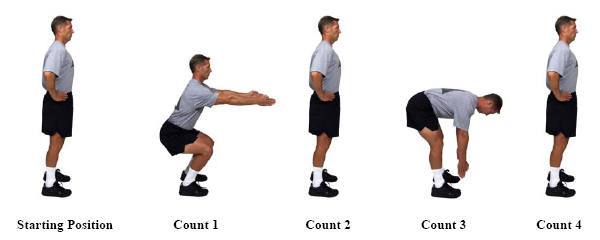
Check Point:
- At the end of counts one, the shoulders, knees and balls of the feet should be aligned. The heels remain on the ground and the back is straight.
- On count three, round the back slightly while bending forward, keeping the head aligned with the spine and the knees slightly bent.
Precautions: This exercise is always performed at a slow cadence. Allowing the knees to go beyond the toes on count one increases stress to the knees.
Conditioning Drill 1
Exercise 6: The Windmill
Purpose: This exercise develops the ability to safely bend and rotate the trunk. It conditions the muscles of the trunk, legs, and shoulders.
Starting Position: Straddle stance with arms sideward, palms facing down.
Cadence: SLOW.
Count:
- Bend the hips and knees while rotating to the left. Reach down and touch the outside of the left foot with the right hand and look toward the rear. The left arm is pulled rearward to maintain a straight line with the right arm.
- Return to the starting position.
- Repeat count one to the right.
- Return to the starting position.

Check Points:
- From the starting position, feet are straight ahead, arms parallel to the ground, hips set, and abdominals tight.
- On counts one and three, ensure that the knees bend during the rotation. Head and eyes are directed to the left foot on count one and the right foot on count three.
Precautions: This exercise is always performed at a slow cadence.
Conditioning Drill 1
Exercise 7: The Forward Lunge
Purpose: This exercise promotes balance and develops leg strength.
Starting Position: Straddle stance with hands on hips.
Cadence: SLOW.
Count:
- Take a step forward with the left leg, allowing the left knee to bend until the thigh is parallel to the ground. Lean slightly forward, keeping the back straight.
- Return to the starting position.
- Repeat count one with the right leg.
- Return to the starting position.
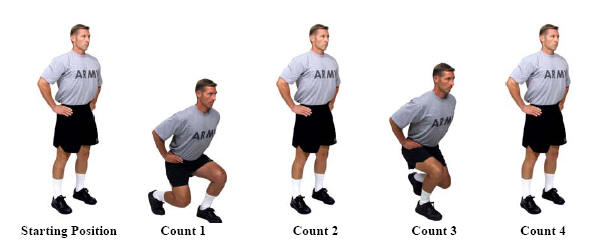
Check Points:
- Keep the abdominal muscles tight throughout the motion.
- On counts one and three, step straight forward, keeping the feet directed forward. When viewed from the front, the feet maintain their distance apart both at the starting position and at the end of counts one and three.
- On counts one and three, the rear knee may bend naturally but do not touch the ground. The heel of the rear foot should be off the ground.
Precautions: This exercise is always performed at a slow cadence. On counts one and three, move into position in a controlled manner. Spring off of the forward leg to return to the starting position. This avoids jerking the trunk to create momentum.
Conditioning Drill 1
Exercise 8: The Prone Row
Purpose: This exercise develops strength of the back and shoulders.
Starting Position: Prone position with the arms overhead, palms down 1-2 inches off the ground and toes pointed to the rear.
Cadence: SLOW.
Count:
- Raise the head and chest slightly while lifting the arms and pulling them rearward. Hands make fists as they move toward the shoulders.
- Return to the starting position.
- Repeat count one.
- Return to the starting position.
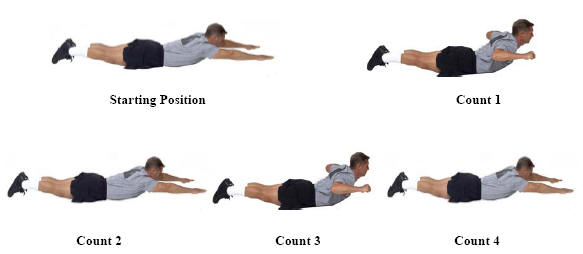
Check Points:
- At the starting position, the abdominal muscles are tight and the head is inline with the spine.
- On counts one and three, the forearms are parallel to the ground and slightly higher than the trunk.
- On counts one and three, the head is raised to look forward but not skyward.
- Throughout the exercise, the legs and toes remain in contact with the ground.
Precautions: This exercise is always performed at a slow cadence. Prevent overarching of the back by maintaining contractions of the abdominal and buttocks muscles throughout the exercise.
Conditioning Drill 1
Exercise 9: The Bent-leg Body Twist
Purpose: This exercise strengthens trunk muscles and promotes control of trunk rotation.
Starting Position: Supine position with the hips and knees bent to 90-degrees, arms sideward, palms down with fingers spread. Legs and feet are together.
Cadence: SLOW.
Count:
- Rotate the legs to the left while keeping the upper back and arms in place.
- Return to the starting position.
- Repeat count one to the right.
- Return to the starting position.
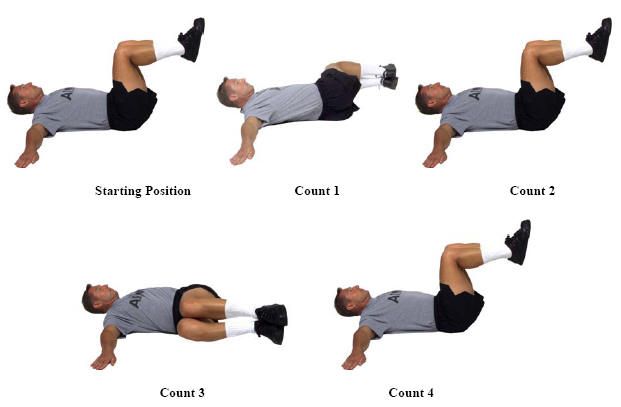
Check Points:
- Tighten the abdominal muscles in the starting position and maintain this contraction throughout the exercise.
- The head should be off the ground with the chin slightly tucked.
- Ensure that the hips and knees maintain 90-degree angles.
- Keep the feet and knees together throughout the exercise.
- Attempt to rotate the legs to about 8-10 inches off the ground. The opposite shoulder must remain in contact with the ground.
Precautions: This exercise is always performed at a slow cadence. Do not rotate the legs to a point beyond which they can no longer maintain contact with the ground with the opposite arm and shoulder.
Conditioning Drill 1
Exercise 10: The Push-up
Purpose: This exercise strengthens the muscles of the chest, shoulders, arms, and trunk.
Starting Position: Front Leaning Rest position.
Cadence: MODERATE.
Count:
- Bend the elbows, lowering the body until the upper arms are parallel with the ground.
- Return to the starting position.
- Repeat count one.
- Return to the starting position.
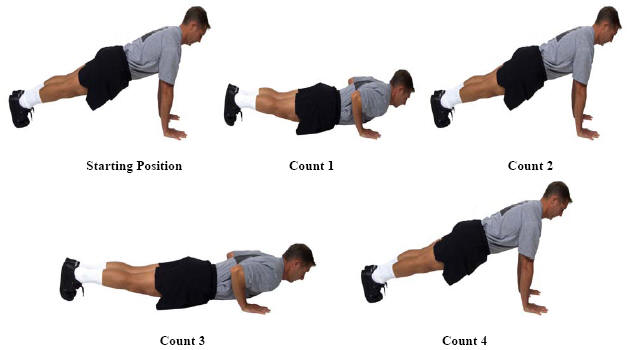
Check Points:
- The hands are directly below the shoulders with fingers spread (middle fingers point straight ahead).
- On counts one and three the upper arms stay close to the trunk, elbows pointing rearward.
- On counts two and four the elbows straighten but do not lock.
- The trunk should not sag. To prevent this, tighten the abdominal muscles while in the starting position and maintain this contraction throughout the exercise.
Precautions: N/A.
Variation: Soldiers should assume the six-point stance on their knees when unable to perform repetitions correctly to cadence.
